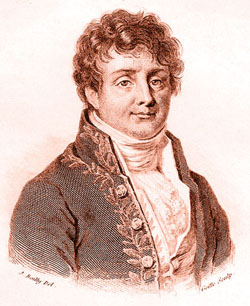
One of the nicest examples of a branch of maths devised to solve one problem, which then solves many other problems, is that of Fourier series. Joseph Fourier was a 19th century French mathematician who was interested in how heat flowed through objects. His first contribution was what is now known as the heat equation: it's an example of a partial differential equation and it describes the way the temperature $T$ of an object depends both on time $t$ and space $x$. In modern notation the heat equation is:
$$\frac{\partial T}{\partial t} = k \frac{\partial^2 T}{\partial x^2},$$ where $k$ is the \emph{thermal conductivity} of the object, a number that measures the object's ability to conduct heat.A solution to the equation, if you can find it, would tell you the temperature $T(x,t)$ of the object at each point $x$ and time $t$. Fourier's first extraordinary insight was that he could solve the heat equation by expressing $T(x,t)$ as a sum of simple functions and then finding the solution in terms of these functions. A good way to think of this is that it is much easier to build a house brick by brick, than to build it in one go. His second extraordinary insight was in his choice of functions to construct the temperature out of. His choice was to use the sine and cosine functions, which arise in trigonometry (the study of triangles) so that he wrote down the expression for $T$ as:
\begin{eqnarray*}T(x,t) & = & \frac{1}{2} a_0(t) & + & \left[a_1(t)\cos{(x)}+b_1(t)\sin{(x)}\right]+ \left[a_2(t)\cos{(2x)}+b_2(t)\sin{(2x)}\right] \\ &&&+& \left[a_3(t)\cos{(3x)}+b_3(t)\sin{(3x)}\right] +\left[a_4(t)\cos{(4x)}+b_4(t)\sin{(4x)}\right]+...\end{eqnarray*} This sum goes on forever — the next term is $\left[a_5(t)\cos{(5x)}+b_5(t)\sin{(5x)}\right]$, the one after $\left[a_6(t)\cos{(6x)}+b_6(t)\sin{(6x)}\right]$ and so on. The $a_0(t)$, $a_1(t)$, $a_2(t)$, etc, and the $b_1(t)$, $b_2(t)$, are coefficients whose exact value depends on the starting conditions (see the box). Such an expression is now called a \emph{Fourier series}.
Jean-Baptiste Joseph Fourier, 1768 - 1830.
Following Fourier's great discovery many mathematicians got to work on extending and generalising his idea, finding many nice results on the way, including a slick derivation of the wonderful formula (originally discovered by Leonhard Euler):
$$\frac{\pi^2}{6} = 1 + \frac{1}{2^2}+\frac{1}{3^2}+\frac{1}{4^2}+\frac{1}{5^2}+...$$Fourier series, and their discrete generalisations on a computer, play a fundamental role in modern technology. In particular we use them to make up, and process, sounds, information and images, and the music, TV and video industry would not exist without them.
Further reading and listening
Find out more about Fourier analysis in this podcast featuring Chris Budd.
For more on applications of the maths inspired by Fourier series, see
- Saving lives: The mathematics of tomography
- Eat, drink and be merry: Making sure it's safe
- Abel to iPod
- Career interview: Audio software engineer
- Career interview: Computer music researcher
About this article

Chris Budd.
This article is adapted from one of Chris Budd's Gresham College lectures, part of a series called Mathematics and the making of the modern and future world. The lectures take place in London, are aimed at a general audience and free to attend.
Chris Budd OBE is Professor of Applied Mathematics at the University of Bath, Vice President of the Institute of Mathematics and its Applications, Chair of Mathematics for the Royal Institution, Gresham Professor of Geometry, and an honorary fellow of the British Science Association. He is particularly interested in applying mathematics to the real world and promoting the public understanding of mathematics.
He has co-written the popular mathematics book Mathematics Galore!, published by Oxford University Press, with C. Sangwin and features in the book 50 Visions of Mathematics ed. Sam Parc.